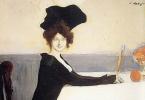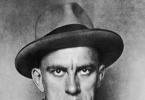The childhood of a writerCHILDHOOD OF A WRITER
Yuri saw the world at its most
the height of severe frosts, in
February 1938, in
city of Moscow. As part of a family
the writer's father (boss)
criminal investigation department of Moscow
region) and mother (chief physician
psychiatric hospital in
Moscow region). Koval Yuri
Iosifovich, whose biography
starts with
Moscow region, spent in this
almost everything is pre-war
childhood.
moved to the Red Gate.
Here Yuri Koval entered the
school and declared himself as
future genius of literature. Behind
boy at school desk
studied math instead
writing poetry. These were
both comic and lyrical
lines, but already so
deep and soulful,
that they touched the thinnest
strings of the soul. After school
Yuri Koval entered the
Pedagogical Institute
named after Lenin in Moscow This man's life was incredible
saturated. Versatile
personality was Yuri Koval,
whose biography tells us
about what his first steps are like
teachers have become promising. He
started his pedagogical
activities in the village of Emelyanovo.
Taught Russian language, literature,
geography, history, singing and others
items. In this moment
Koval's activities as a writer
became more active, but, unfortunately, not
all works were published. I came up with funny stories that helped
students quickly remember the rules of Russian
grammars. Russian children's writer, author of children's
films, artist
and sculptor, also cartoon screenwriter
and singer-songwriter.
Yuri Koval is one of the most famous and
favorite children's writers of the USSR and Russia. For some time he published individual works
in popular magazines "Children's Literature",
“Ogonyok”, “Smena”, “Murzilka”, “Pioneer”.
Collaborated with the publishing house "Malysh", which
published his first children's book. The beginning of Yuri's creativity
Farrier for children was
supposed to happen by chance when he
decided to leave my job
teachers and just do
creativity. And then one day
magazine "Murzilka"
invited him to go to
border to
see with your own eyes how life is
and serves the border guards, and
then write about them
poem. Returning
impressed by what he saw
Koval wrote a story
"Scarlet". Then he accepted
decision to write only for
children. The literary legacy of Yuri Koval lay
the basis of several children's films,
cartoons and animated films Yuri Koval is not known
only as a writer, but also as
artist. He was addicted
fresco, mosaic, drawing,
sculpture, carving
wood, enamel, painting in
different techniques. How
artist Yu. Koval
participated in many
personal and group
exhibitions.
At the workshop
AT THE WORKSHOPawards
AWARDSFor his works he was awarded numerous awards at the All-Union competition for the best work for
children (1971), honorary diploma named after. A. P. Gaidar (1983),
"Anderson Diploma" - an honorary diploma
International Council on Children and Youth
literature (1986), prize of the All-Union competition for the best
children's book (1987), prize "Wanderer" of the International
Congress of Science Fiction Writers (1996, posthumously). Books
Yuri Koval have been translated into several European languages,
into Chinese and Japanese. Many of his works
filmed. And although Koval's eye is merciless
vigilant, as the eye should be
artist, but here is his look
invariably kind and sympathetic to the world and
to the living souls that inhabit it,
what the look should be
a real Russian writer.
DRAWINGS BY OUR READERS FROM THE BOOK
Y. KOVALYA.
TAKE PART IN THE COMPETITION
DRAWINGS!
? With. 123 - 124 Is the hero of this story the same as in other works of Yuri Koval you are familiar with? Why do you think so?
The main character of this story, a young writer living in the village, is the same one with whom we have already met in the works of Yuri Koval (“Bullfinches and Cats”, “In the Birches”, “Flight” - textbook “Literary Reading”, 1– 2nd grade; “Three Jays” - textbook “Literary Reading”, 2nd grade, part 2; “Birch Pie”, “Water with Closed Eyes” - textbook “Literary Reading”, 3rd grade, part 1). You can come to this conclusion if you pay attention to how detailed and lovingly the hero of the story describes nature, how accurately he notices details that are invisible at first glance, and what accurate comparisons and descriptions he gives.
? Is the hero an observant person?
Of course, the hero of this story is a very observant person, capable of apt and witty comparisons: “The hillock was completely strewn with ladybugs, like the swamp hummocks of old with cranberries”; “The ladybugs took off, and then you could see a brick and transparent dot twisting between the trunks.”
? What forest sounds (besides the voice of copper pipes) does the hero hear? Read the lines that talk about this. Confirm with lines from the text that the hero of the story knows the natural world and its inhabitants well.
The hero hears many forest sounds: the noise of falling cones, the hum of pine trees, and the “conversation” of black grouse: “You could hear the pine branches rustling and the black grouse muttering and muttering far away.” The mound itself, on which the young writer fell asleep, was “like a huge crooked drum”; it “hoots and hums dully.” Having woken up, the hero of the story hears how “a finch was beating on the lower branches of the pine tree,” and the pine tree itself was making some sounds: “I put my ear to the pine trunk: I heard a noise, distant, like in a sea shell.”
The young writer is sincerely interested in nature, loves it and knows a lot about the forest: “...I was completely exhausted after a sleepless night on a capercaillie lek”; “A moose, or what?.. no, it doesn’t look like it. The moose rut in the fall... The moose doesn’t know how to trumpet like that. His voice is a groan, dull, hoarse... This is not an elk or a crane...”; “...there was an underground stream in the hillock - it was playing, choking on spring water.”
? Why then is the story placed in this chapter, and not in the chapter “Learning to Observe”?
Did the place in the forest that the hero spoke about preserve the memory of distant war days, of the fate of our soldiers?
Often the things and photographs that surround your great-grandparents preserve the memory of the past, the history of not only a particular family, but the entire country.
And yet, the story is placed precisely in the chapter “Comparing the Past and the Present,” and not in the chapter “Learning to Observe.” The main thing in the story is to describe the beauty of the spring forest? What did the hero of the story learn when he returned home? That somewhere in the forest during the war the instruments of the regimental orchestra were hidden, which they could not find later. What was he thinking? That those same “copper, lifeless” sounds of trumpets and strings that he heard in the forest were the sounds of buried instruments, reminiscent of the fate of a military orchestra during a long-standing war.
Description of the presentation by individual slides:
1 slide
Slide description:
Yuri Iosifovich Koval Biography. Creation. The work was completed by 9th grade student Suzanna Sargsyan. 2015 MBOU "Nikolskaya Secondary School"
2 slide

Slide description:
3 slide

Slide description:
Yuri Iosifovich Koval was born on February 9, 1938 in Moscow. His father served in the criminal investigation department, and his mother was the chief physician of a psychiatric hospital in Polivanov. His childhood during the war, evacuation, hunger and cold of those years affected his life with bone tuberculosis.
4 slide

Slide description:
In 1955, after school, he entered the Lenin Pedagogical Institute at the Faculty of Russian Language and Literature, which later became known as the Faculty of History and Philology. After graduating from the institute, in 1960 he received the specialty of teaching Russian language and literature, history and drawing. At the institute, he discovered his talent for drawing and sculpture, played the piano, banjo, and guitar, and wrote poetry and prose for the institute newspaper.
5 slide

Slide description:
The beginning of literary activity After graduation, Yuri Koval was sent on assignment to the village of Emelyanovo, Laishevsky district of the Tatar Autonomous Soviet Socialist Republic. There he worked at a school until 1963, and was a teacher of various subjects: Russian language and literature, geography, history, singing, etc. Then, in the early 1960s, he began to more actively write poetry and stories, many of which, however, , were never published. Dictations for students were also sometimes written in poetic form; the most famous is the following quatrain (for the spelling of hissing words): A mouse was sitting on the floor. Suddenly a formidable husband runs in, and, grabbing a huge knife, he crawls toward the mouse like a snake.
6 slide

Slide description:
In 1963, Koval starred in a small episode in Theodor Vulfovich’s feature film “Newton Street, Building 1” based on the play by Edward Radzinsky - in the film he and Yuli Kim sing with a guitar at a youth party.
7 slide

Slide description:
In 1966, the first children's books of Koval's poems, written together with Leonid Mezinov, were published - “The Tale of How the House was Built” and “The Tale of the Teapot”. Then he published other collections of children's poems - “Moose Station” (1967) and “Elephants on the Moon” (1969).
8 slide

Slide description:
In 1968, Koval received from the magazine “Murzilka” a business trip to the border guards, the impressions of which formed the basis for the story “Scarlet” and the stories “Visor”, “Special Assignment”, “Elets” and “White Horse”. As the writer himself recalled, while writing “Scarlet” he “caught prose by the tail”: “I finally wrote such a thing when I made up my mind and one could say that the writer Koval wrote it.”
Slide 9

Slide description:
The next success was the collection of stories “Clean Dor” (1970), dedicated to the life of the Vologda village of the same name. Koval loved these places and often visited them, including in the vicinity of the famous monastery in Ferapontovo and on Tsypina Gora.
10 slide

Slide description:
Work of the 1970s-80s In the genre of a humorous detective story, the story “The Adventures of Vasya Kurolesov” (1971) was written, which was subsequently used as a cartoon (1981). It was largely based on the stories of the writer’s father about working in the police. My father was a very funny man. Very funny... He knew how to amuse the audience with anything, with any story. He instantly made me laugh... And he loved all my books very much, and read them willingly, and willingly quoted them. True, at the same time he said: “In essence, I suggested everything to Yurka.”
11 slide

Slide description:
In 1972, Yuri Koval became a member of the USSR Writers' Union. The recommendation was given to him by none other than Boris Shergin - him, as well as another outstanding writer of the Russian North. Yuri Koval loved to travel, especially to remote corners and small villages of the Urals and the Russian North, where he sometimes lived for weeks and months. Car and foot travel around the Vologda region and life on Tsypina Gora near the Ferapontov Monastery shaped the writer’s interest in traditional village and especially northern Russian life and language. In 1984, Koval even began construction of his house on Tsypina Gora, but this house was not completed, and subsequently Koval lived in his other village house in Plutkovo on the Nerl River, not far from Kalyazin. Travels along the northern rivers are reflected in the story “The Lightest Boat in the World” (1984), which was awarded an Honorary Diploma of the International Board of Literature for Children and Youth (IBBY) in 1986.
12 slide

Slide description:
Creativity of the 1990s In the last years of his life, Yuri Koval completed his main (and largest in volume) work - “Suer-Vyer”, which he himself defines not as a novel or story, but as a “parchment”. In a conversation with Irina Skuridina in March 1995, Koval spoke about him like this: It’s written there... It’s written there, that’s all. Understand. That's it!.. I think that I wrote a thing equal in rank to Rabelais, and Cervantes, and Swift, I think. But I could be wrong...
Y. Koval “Birch Pie”
The Mokhov brothers and Nyurka went into the forest to pick berries, and so I went, on my own.
And even though I was walking on my own, and they were as big as berries, we still ended up side by side all the time. I’m walking, and either Nyurka looks out from the side, or some brother Mokhov.
I turn to the side to be in silence, and the other brother Mokhov is crawling out of the bushes. These brothers were especially annoying - they fought with cans, threw money, or suddenly started shouting:
Nyurka was quieter, but when it came to the pig, she also screamed with all her might:
- We need to pin up the pig! We need to pin up the pig!
- Hey! - I shouted. - Who are you kidding there?
- Pig! - the Mokhov brothers responded in unison.
- What other pig? Bring her here!
The Mokhov brothers and Nyurka jumped out of the bushes with cans in their hands; no pig was visible.
-Where is the pig? - I asked sternly.
“Here,” Nyurka said and handed me a blade of grass on which strawberries were strung.
“Strawberries,” I said.
“Strawberries,” Nyurka agreed. - But only a pig.
I took a closer look and saw that the berries strung on the stem were especially large, especially ripe, black with deep redness. I took the berry off the stem, put it in my mouth and realized that it had a special taste. Simple strawberries have a sunny taste, but here they have a forest, swamp, gloomy taste.
Apparently, this berry ripened for a long time, gained sun and juice, and became the best of strawberries.
I found a suitable blade of grass, pulled out a stem from it and, together with the guys, began to pick berries and shout:
- We need to pin up the pig! We need to pin up the pig!
Soon my blade of grass became heavy from the strawberries strung on it. It was nice to carry it, wave it, look at it.
By lunchtime the guys' cans were full, and I pinned the pig with five blades of grass. We sat down to rest. We could have had a snack here, but none of us took any crackers or flatbread into the forest.
- We need to chop the pig! - the Mokhov brothers shouted.
“We’ll take what we’ve collected home,” said Nyurka. - Wait, I’ll bake some pies now.
She picked a leaf from a birch branch, wrapped five strawberries in it and handed it to me first, as the eldest.
- What is this? - I asked.
- Birch pie. Eat.
The birch pie turned out to be very tasty. He smelled of strawberries and the sun, forest summer, deep forest.
Slide 1
Slide description:
Slide 2
Slide description:
Slide 3
Slide description:
Slide 4
Slide description:
Slide 5
Slide description:
Slide 6
Slide description:
Slide 7
Slide description:
Slide 8
Slide description:
Slide 9
Slide description:
Slide 10
Slide description:
Slide 11
Slide description:
Slide 12
Slide description:
Slide 13
Slide description:
Slide 14
Slide description:
Slide 15
Slide description:
Slide 16
Slide description:
Slide 17
Slide description:
Slide 18
Slide description:
Slide 19
Slide description:
Slide description:We all come from childhood, we all come from childhood - that’s what they say. But you don’t often hear about an adult: he remained in childhood. This is a special and very rare gift. Yuri Koval possessed it to the fullest extent, being at the same time a very adult person, extremely responsible towards people and animals, and most importantly - by the way, towards his own creativity. “The prose should be such that you are ready to kiss every line written,” said Yuri Koval. He wrote not easily, often painfully. He wrote his best books, which are not at all large in length, over the years. But they are written in such a way that each line shines like a poetic diamond and contains a classic polysemy of meaning, which is why Koval’s books, which amaze you from the first reading, should be re-read throughout your life, because they reveal different secrets to each age. ! 1970, having written “Clean Dor”, Yuri Koval finally and irrevocably decided to become a children’s writer. “Everything I could say to adults, I say to children, and they seem to understand me. It was the study of children’s literature that purified my style, clarified my thoughts, and squeezed the water out of my works.” The study of Koval’s work is practically just beginning, despite the fact that his books have long been rightfully included in the “golden fund” of Russian literature – both children’s and adult. Therefore, a real, deep comprehension of his work, his personality, determination of his true place in the ranks of Russian classics is still ahead. In the meantime, we have his books, films, memories of him, which are becoming more and more every day. Writer Yuri Koval is one of those whose posthumous fame far exceeds his lifetime recognition. The writer has done a lot of good things during his life. Fascinating, different stories from one another: “Under Sands”, “The Adventures of Vasya Kurolesov”, “The Lightest Boat in the World” and many others. Koval's books make us kinder, more uncompromising to all evil, cruelty, and spiritual deafness. These books are loved by many thousands of young and adult readers. Every time we reread the books of Yuri Koval, we are glad that a wise writer lived in the world with a magic lantern in his hand.
Slide 22
Slide description:




